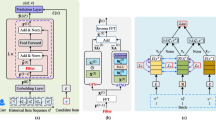Abstract
Recommendation system facilitates users promptly obtaining the information they need in this age of data explosion. Research on recommendation models have recognized the importance of integrating user historical behavior sequence into the model to alleviate the matrix sparsity. Although deep learning algorithm with attentive mechanism exhibits competitive performance in sequential recommendation, the searching for optimal attentive factors still lack effectiveness. In this work, we redesign the sequential recommendation model by employing swarm intelligence for optimization in the attentive mechanism thus to improve the algorithm accuracy. We conduct extensive comparative experiments to evaluate performance of four swarm intelligence algorithms and traditional recommendation methods. Our work is the first attempt to integrate swarm intelligence into sequential recommendation algorithm. Experimental results confirmed the superior performance on AUC score of the proposed approach.
Access this chapter
Tax calculation will be finalised at checkout
Purchases are for personal use only
Similar content being viewed by others
References
Sarwar, B., Karypis, G., Konstan, J.: Item-based collaborative filtering recommendation algorithms. In: Proceedings of the 10th International Conference on World Wide Web, pp. 285–295 (2001)
Koren, Y.: Factorization meets the neighborhood: a multifaceted collaborative filtering model. In: Proceedings of the 14th ACM SIGKDD International Conference on Knowledge Discovery and Data Mining, pp. 426–434 (2008)
Kabbur, S., Ning, X., Karypis, G.: FISM: factored item similarity models for top-N recommender systems. In: Proceedings of the 19th ACM SIGKDD International Conference on Knowledge Discovery and Data Mining, pp. 659–667 (2013)
Zhou, G., Zhu, X., Song, C.: Deep interest network for click-through rate prediction. In: Proceedings of the 24th ACM SIGKDD International Conference on Knowledge Discovery and Data Mining, pp. 1059–1068 (2018)
He, X., He, Z., Song, J.: NAIS: neural attentive item similarity model for recommendation. IEEE Trans. Knowl. Data Eng. 30(12), 2354–2366 (2018)
Geng, S., He, X., Wang, Y.: Multicriteria recommendation based on bacterial foraging optimization. Int. J. Intell. Syst. 37(2), 1618–1645 (2022)
Choudhary, V., Mullick, D., Nagpal, S.: Gravitational search algorithm in recommendation systems. In: Tan, Y., Takagi, H., Shi, Y., Niu, B. (eds.) ICSI 2017. LNCS, vol. 10386, pp. 597–607. Springer, Cham (2017). https://doi.org/10.1007/978-3-319-61833-3_63
Yadav, S., Nagpal, S.: An improved collaborative filtering based recommender system using bat algorithm. Procedia Comput. Sci. 132, 1795–1803 (2018)
Xia, X., Wang, X., Li, J.: Multi-objective mobile app recommendation: a system-level collaboration approach. Comput. Electr. Eng. 40(1), 203–215 (2014)
Yuan, F., Karatzoglou, A., Arapakis, I.: A simple convolutional generative network for next item recommendation. In: Proceedings of the Twelfth ACM International Conference on Web Search and Data Mining, pp. 582–590 (2019)
Hidasi, B., Karatzoglou, A.: Recurrent neural networks with top-k gains for session-based recommendations. In: Proceedings of the 27th ACM International Conference on Information and Knowledge Management, pp. 843–852 (2018)
Kang, W.C., McAuley, J.: Self-attentive sequential recommendation. In: IEEE International Conference on Data Mining (ICDM), pp. 197--206. IEEE (2018)
Katarya, R.: Movie recommender system with metaheuristic artificial bee. Neural Comput. Appl. 30(6), 1983–1990 (2018)
Katarya, R., Verma, O.P.: Efficient music recommender system using context graph and particle swarm. Multimed. Tools Appl. 77(2), 2673–2687 (2018)
Perozzi, B., Al-Rfou, R., Skiena, S.: Deepwalk: online learning of social representations. In: Proceedings of the 20th ACM SIGKDD International Conference on Knowledge Discovery and Data Mining, pp. 701–710 (2014)
Mikolov, T., Sutskever, I., Chen, K.: Distributed representations of words and phrases and their compositionality. In: Advances in Neural Information Processing Systems, pp. 3111–3119 (2013)
Goldberg, Y., Levy, O.: Word2vec explained: deriving Mikolov et al.’s negative-sampling word-embedding method. arXiv preprint. arXiv:1402.3722 (2014)
Kennedy, J., Eberhart, R.: Particle swarm optimization. In: Proceedings of ICNN 1995-International Conference on Neural Networks, vol. 4, pp. 1942–1948. IEEE (1995)
Karaboga, D., Basturk, B.: On the performance of artificial bee colony (ABC) algorithm. Appl. Soft. Comput. 8(1), 687–697 (2008)
Passino, K.M.: Biomimicry of bacterial foraging for distributed optimization and control. IEEE Control Syst. Mag. 22(3), 52–67 (2002)
Yang, X.S.: Nature-Inspired Metaheuristic Algorithms. Luniver Press (2010)
Schafer, J.B., Frankowski, D., Herlocker, J., Sen, S.: Collaborative filtering recommender systems. In: Brusilovsky, P., Kobsa, A., Nejdl, W. (eds.) The Adaptive Web. LNCS, vol. 4321, pp. 291–324. Springer, Heidelberg (2007). https://doi.org/10.1007/978-3-540-72079-9_9
Koren, Y., Bell, R., Volinsky, C.: Matrix factorization techniques for recommender systems. Comput. 42(8), 30–37 (2009)
Ning, X., Karypis, G.: SLIM: sparse linear methods for top-n recommender systems. In: 2011 IEEE 11th International Conference on Data Mining, pp. 497–506. IEEE (2011)
Acknowledgement
This study is supported by National Natural Science Foundation of China (71901150, 71901143), Natural Science Foundation of Guangdong (2022A1515012077), Guangdong Province Innovation Team “Intelligent Management and Interdisciplinary Innovation” (2021WCXTD002), Shenzhen Higher Education Support Plan (20200826144104001).
Author information
Authors and Affiliations
Corresponding author
Editor information
Editors and Affiliations
Rights and permissions
Copyright information
© 2022 Springer Nature Switzerland AG
About this paper
Cite this paper
Geng, S., Liang, G., He, Y., Duan, L., Xie, H., Song, X. (2022). Swarm Enhanced Attentive Mechanism for Sequential Recommendation. In: Tan, Y., Shi, Y., Niu, B. (eds) Advances in Swarm Intelligence. ICSI 2022. Lecture Notes in Computer Science, vol 13344. Springer, Cham. https://doi.org/10.1007/978-3-031-09677-8_37
Download citation
DOI: https://doi.org/10.1007/978-3-031-09677-8_37
Published:
Publisher Name: Springer, Cham
Print ISBN: 978-3-031-09676-1
Online ISBN: 978-3-031-09677-8
eBook Packages: Computer ScienceComputer Science (R0)




